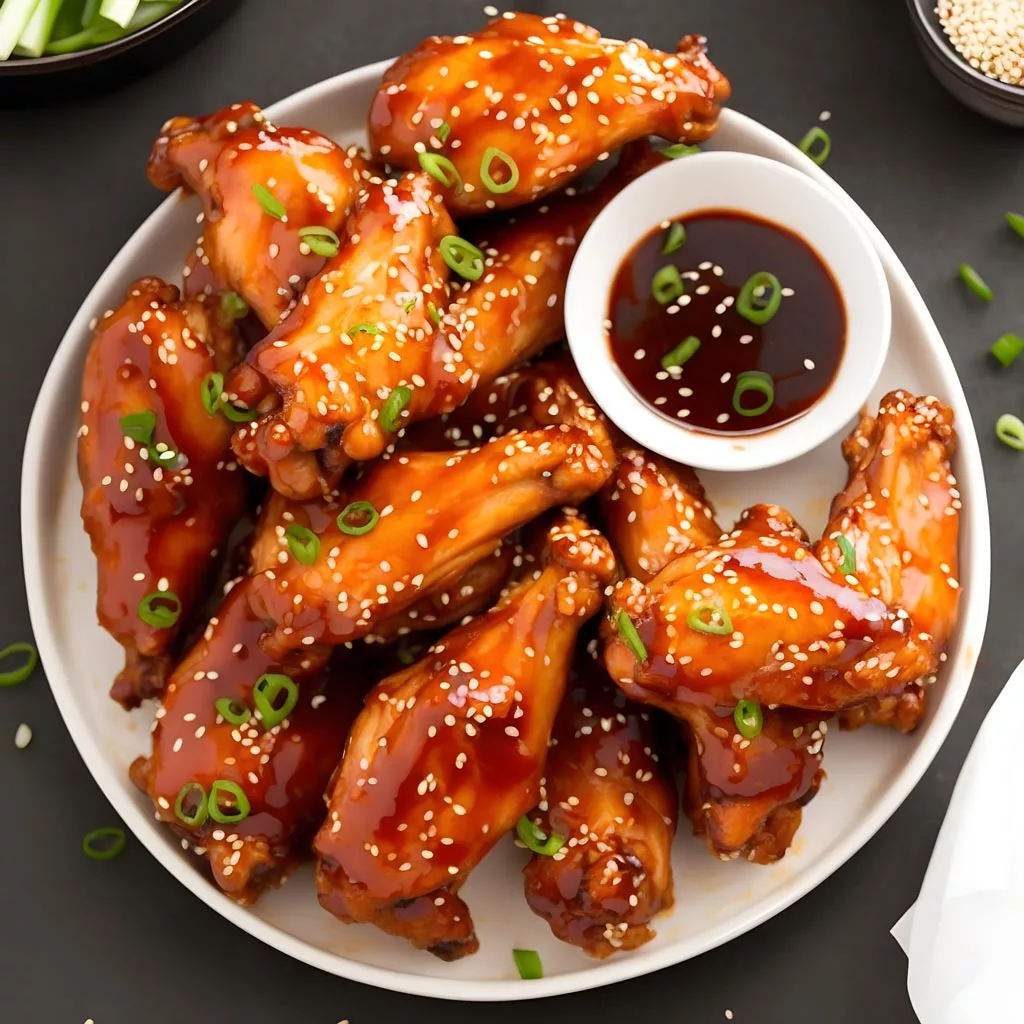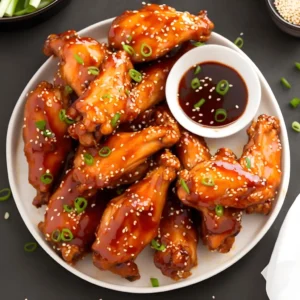
Craving a flavor-packed dish that’s sure to impress your taste buds? Look no further than these tantalizing Korean Chicken Wings!
Originating from the vibrant culinary landscape of Korea, this recipe brings together the bold flavors of Korean cuisine with the crispy goodness of fried chicken wings. Whether you’re hosting a game day gathering or simply looking for a delightful meal, these wings are guaranteed to be a hit.
While the concept of chicken wings might be familiar, the magic lies in the sauce. Our Korean-inspired sauce is a harmonious blend of sweet, savory, and spicy notes, featuring Gochujang Korean chili paste, honey, soy sauce, and a hint of sesame oil.
Each ingredient plays a crucial role in elevating the taste, creating a symphony of flavors that dance on your palate.
Don’t be intimidated by the thought of frying chicken wings at home. With a few simple steps and pantry staples, you can achieve crispy perfection right in your kitchen.
Whether you’re a seasoned home cook or just starting your culinary journey, this recipe offers a delightful balance of simplicity and flavor complexity.
Expert Tip: For extra crispy wings, ensure the oil is hot enough before frying. You can test the temperature by dropping a small piece of bread into the oil.
Chicken Wings: These offer juicy and tender meat that pairs perfectly with the crispy coating and flavorful sauce.
Plain Flour: Coats the chicken wings, creating a crispy exterior when fried.
Salt: Enhances the overall flavor of the wings and helps to season the flour mixture.
Garlic Powder: Adds a savory depth of flavor to the wings, complementing the other spices in the coating.
Onion Powder: Provides a subtle sweetness and depth of flavor to the coating, enhancing the overall taste.
Paprika: Imparts a mild, smoky flavor and adds a vibrant color to the coating.
Cayenne Pepper: Offers a gentle kick of heat to the wings, balancing the sweetness of the sauce.
Baking Powder: Helps to achieve an extra crispy texture when frying the wings.
Vegetable Oil: Used for frying the wings to golden perfection.
Gochujang: Korean chili paste adds a rich, spicy flavor base to the sauce, essential for authentic Korean cuisine.
Honey: Balances the heat of the Gochujang with its natural sweetness, creating a harmonious flavor profile.
Soy Sauce: Provides depth of flavor and umami richness to the sauce.
Rice Vinegar: Adds a tangy brightness to the sauce, cutting through the richness of the other ingredients.
Sesame Oil: Infuses the sauce with a nutty aroma and depth of flavor, characteristic of Korean cuisine.
Garlic: Contributes aromatic pungency and savory notes to the sauce.
Ginger: Offers a fresh, zesty flavor that complements the other ingredients in the sauce.
Water: Helps to adjust the consistency of the sauce, ensuring it coats the wings evenly.
Sesame Seeds: Garnish for the wings, adding visual appeal and a hint of nuttiness.
Spring Onions: Another garnish that provides a pop of color and a mild onion flavor to the dish.
Expert Tip: Don’t overcrowd the frying pan when cooking the wings. Fry them in batches.
Expert Tip: For a glossy finish, brush the cooked wings with a little extra sauce before serving.
Yes, you can bake the chicken wings for a healthier alternative. Place them on a baking sheet lined with parchment paper and bake in a preheated oven at 200°C (400°F) for approximately 45-50 minutes, or until they are cooked through and crispy.
Absolutely! Feel free to adjust the amount of Gochujang and cayenne pepper according to your spice preference. If you prefer a milder sauce, reduce the amount of Gochujang and omit the cayenne pepper altogether.
Store any leftover chicken wings in an airtight container in the refrigerator for up to 3 days. Reheat them in the oven or microwave until heated through before serving.
Yes, you can use chicken drumsticks or even chicken thighs for this recipe. Adjust the cooking time accordingly, as drumsticks and thighs may require slightly longer cooking.
Certainly! You can prepare the sauce in advance and store it in an airtight container in the refrigerator for up to a week. Simply reheat it gently on the stove or in the microwave before tossing with the cooked chicken wings.
Here are some more recipes for you to enjoy! If you my recipes don’t forget to rate and leave a comment.
If you have any recipe suggestions, please do not hesitate to ask me. A great way to stay in contact with me is through Instagram, Facebook, Twitter and YouTube. Don’t forget to tag me @CookwithNabeela in your recipe photos!

Subscribe now to receive my latest recipes directly in your inbox. Stay up-to-date and never miss out!

I love to cook! I want to share with you my favourite, delicious family-friendly recipes. I want to inspire you to create fantastic food for your family every day.
Add your first comment to this post